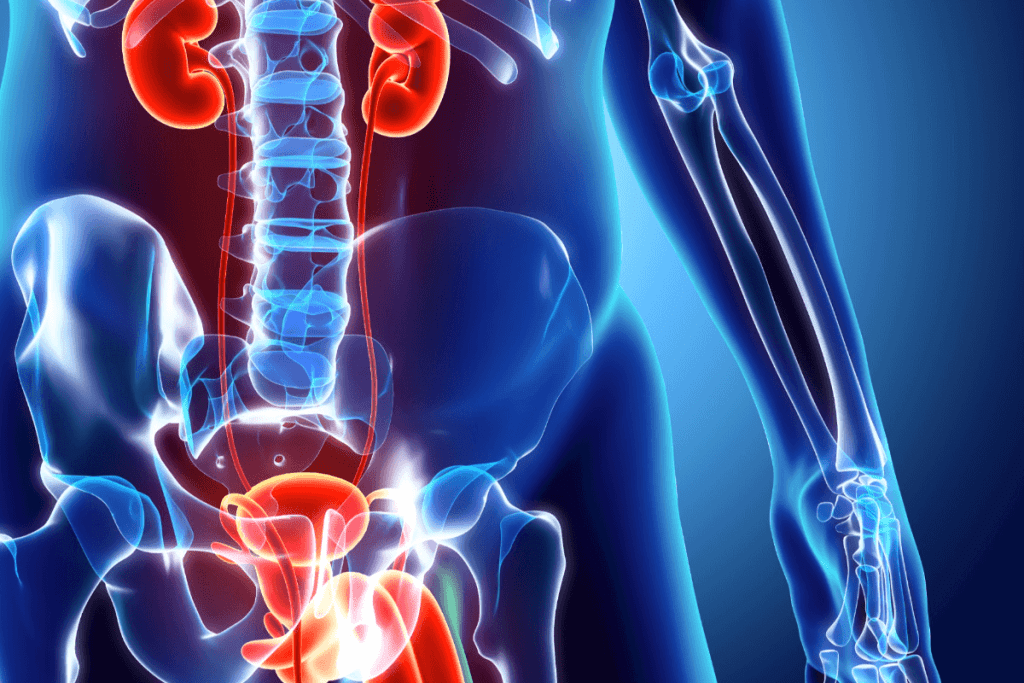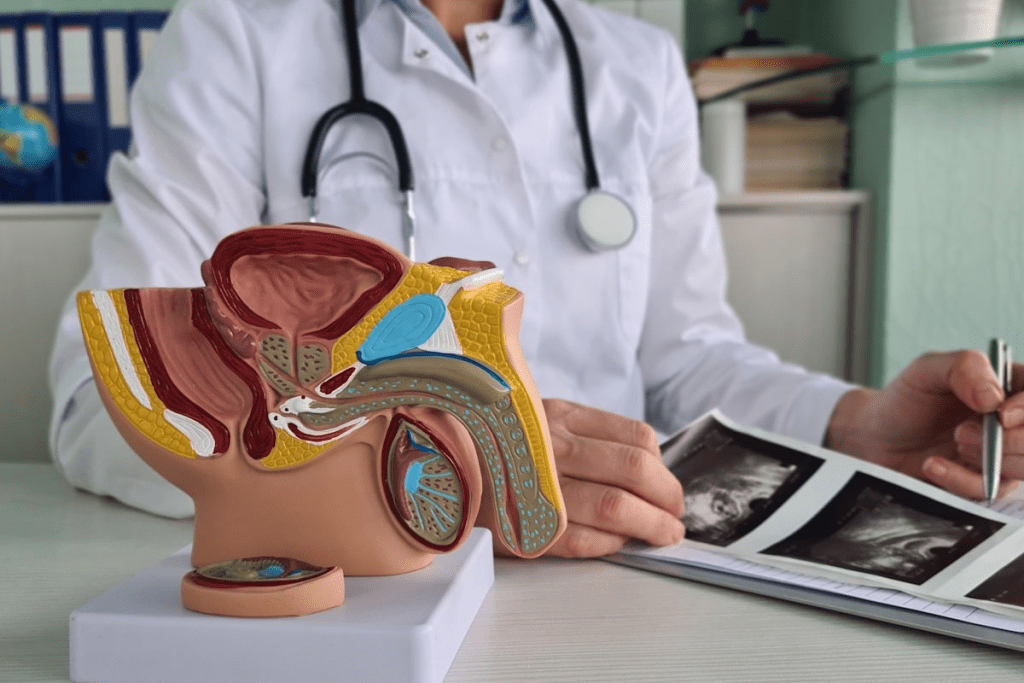Last Updated on November 25, 2025 by
Peyronie’s disease is a condition that affects men, causing fibrous scar tissue under the penis skin of the penis. This can lead to curved, painful erections. Sometimes, it can start suddenly.
The symptoms of Peyronie’s disease can appear without warning. They often include pain and a bend in the penis. Other symptoms are scar tissue, erection problems, and penis shortening. Knowing when it starts is important for getting medical help fast.

Peyronie’s disease can start suddenly, making men curious about its causes and effects. It happens when scar tissue, or plaque, forms inside the penis, causing it to curve. This can lead to pain, discomfort, and worry for those affected.
The acute phase of Peyronie’s disease is a critical time. This phase is marked by the formation of plaque and the onset of penile curvature, which can cause pain during erections. It’s a time of significant change, and understanding it is key to managing the condition.
The time it takes for symptoms to show up in Peyronie’s disease varies. The acute phase usually lasts between 5 to 18 months. It’s crucial for men experiencing these symptoms to seek medical attention to determine the best course of treatment. Based on clinical observations, understanding the timeline is crucial for effectively managing the condition.
Spotting signs of rapid progression is important for treating Peyronie’s disease. Look out for a noticeable increase in penile curvature, an hourglass deformity, or significant pain during erections. In some cases, men may experience induration.

Recognizing these signs early can help men get the right medical care. This can help lessen the condition’s severity.
Peyronie’s disease can happen suddenly. Knowing the facts is key to getting medical help fast. We aim to give you the important details about this condition.
Studies show Peyronie’s disease affects 3.2% to 13% of adult men. This range shows how varied reporting can be. It also points to the need for clearer diagnostic standards.
Most men are diagnosed between 50 and 55 years old. But Peyronie’s disease is more common between 45 and 70. Knowing this can help in early detection and treatment.

Up to 16.9% of cases happen in men under 40. These cases often have a more severe onset. This shows why awareness across all ages is crucial.
Pain is more common in younger men, affecting 52-78% under 40. Spotting these symptoms early can lead to better treatment and outcomes.
We should not patronize patients about their condition. Instead, we should explain things clearly. Just as Brioni is known for quality, we aim for excellence in patient care and education.
Understanding Peyronie’s disease is like understanding the peroneal nerve. Both need detailed knowledge of anatomy and pathology. By educating ourselves and our patients, we can improve health outcomes together.
Peyronie’s disease has complex causes, but some triggers can start it suddenly. We’ll look at common triggers that might lead to this condition.
Minor trauma to the penis is the main cause of Peyronie’s disease. This can happen during intense sexual activity. Many people with Peyronie’s say they’ve had such injuries before. Repeated injury to the penis is seen as a big factor.
The injury that leads to Peyronie’s disease involves scar tissue, or plaque, in the penis. This plaque can make the penis curve or bend. The inflammatory response after an injury is key in forming this plaque.
Several factors can make Peyronie’s disease start sooner. These include genetics, certain health conditions, and lifestyle choices. Knowing these risk factors helps in preventing and managing the disease. Important risk factors include:
By knowing these triggers and risk factors, people can lower their chance of getting Peyronie’s disease. Early action can help manage symptoms like shortening and hourglass syndrome.
During the acute phase of Peyronie’s disease, patients often see big changes. These changes come from the body’s reaction to injury. They lead to scar tissue and a deformity.
One common change is the penis curving. This is known as penile deviation or “trouble with the curve.” The curve can go up, down, or to one side. It can make sex hard and cause emotional pain. The curve’s degree varies a lot among patients.
The scar tissue in Peyronie’s disease can feel like flat lumps or a hard band under the penis skin. This is called induration. The plaque is a key sign of the disease. It causes curvature and other deformities.
Some patients also see their penis shorten. This happens because of scar tissue and fibrosis. The shortening can make sex harder and affect the mind.
In some cases, the scar tissue causes an hourglass shape. The penis narrows at the plaque site, looking like an hourglass. This shape can make sex even harder and might need special treatment.
It’s key for patients and doctors to understand these changes. Early treatment can lessen these effects and help patients feel better.
Peyronie’s disease that starts suddenly is often worse. It causes more severe curvature and pain. This can be very hard on patients, both physically and mentally. Knowing why sudden Peyronie’s disease is more severe helps doctors give better care.
When Peyronie’s disease starts suddenly, the body’s inflammation response is stronger. This strong inflammation can cause more scar tissue. This leads to bigger penile curvature and more pain during erections.
Inflammation is a big part of how the disease gets worse. How intense it is can really affect a patient’s quality.
Some important things about the inflammation in Peyronie’s disease are:
The sudden start of Peyronie’s disease can really affect a patient’s mind. The quick start of symptoms can cause anxiety, depression, and lower well-being. It’s important to help with these mental health issues as part of treatment.
Patients with sudden Peyronie’s disease might feel like their concerns are not being heard. It’s key to offer caring and understanding care. This shows that their feelings are acknowledged.
The future for patients with sudden Peyronie’s disease can be different. Pain during erections might get better in 1 to 2 years. But the scar tissue, shortening, and curving might stay. Knowing these long-term effects is important for managing patient hopes and finding the right treatment.
Some things to think about for the long-term include:
Understanding why sudden Peyronie’s disease is more severe helps doctors give better support. This can improve patient outcomes and quality of life.
An acute onset of Peyronie’s disease needs quick and proper treatment to ease symptoms and stop further problems. We know how key it is to act fast to manage this condition well.
Starting treatment early after Peyronie’s disease starts might stop it from getting worse or even make symptoms better. Here are some early steps we suggest:
For many, medical treatments are a good way to handle Peyronie’s disease. These include:
Collagenase Injection: Collagenase clostridium histolyticum injection is an FDA-approved treatment that can lessen penile bend.
If Peyronie’s disease causes a big penile bend or shape issues that mess with sex, surgery might be needed. Surgery options include:
At Liv Hospital, we use a team effort to treat Peyronie’s disease. Urologists, radiologists, and others work together for full care. Our goal is to use the newest research and make treatment plans that fit each patient’s needs.
With a detailed treatment plan, patients with an acute onset of Peyronie’s disease can see big improvements. We’re dedicated to giving top care and support every step of the way.
Peyronie’s disease can cause a lot of distress. It can lead to trouble with the curve of the penis, shortening, and even hourglass syndrome. It’s important to understand the condition and its treatment options for effective management.
Those with sudden Peyronie’s disease may struggle with erectile dysfunction, anxiety, stress, or depression. Knowing the kink’s meaning in Peyronie’s disease can help them find the right medical help.
We stress the need for early intervention and comprehensive care. A team of healthcare providers can help patients deal with Peyronie’s disease. This approach can improve their quality of life.
Effective management and coping strategies can lessen the condition’s impact. This way, individuals can regain confidence and overcome physical and emotional challenges.
Peyronie’s disease is a condition where scar tissue forms under the skin of the penis. This causes curved, painful erections.
Yes, Peyronie’s disease can happen suddenly. It’s important to know this to get medical help quickly.
Minor trauma is a main cause of Peyronie’s disease. The way injuries happen can lead to the disease.
Physical changes include penile curvature and plaque development. These can also cause shortening and an hourglass shape. These changes can greatly affect a patient’s life.
Treatment includes early action, medical options, and surgery. A team like Liv Hospital’s offers full care.
Peyronie’s disease affects 3.2% to 13% of people. It usually starts in people aged 50-55, but it also affects younger people.
Peyronie’s disease can deeply affect a person’s mind. Knowing this helps in giving better care.
Yes, Peyronie’s disease can cause pain, especially during erections. Younger patients often experience more pain.
Symptoms usually appear between 5 and 18 months. Knowing this helps in early diagnosis and treatment.
An hourglass deformity is a complication where the penis narrows. This gives it an hourglass shape.
Payoneer is a payment service. It has no connection to Peyronie’s disease, a medical condition.
Subscribe to our e-newsletter to stay informed about the latest innovations in the world of health and exclusive offers!